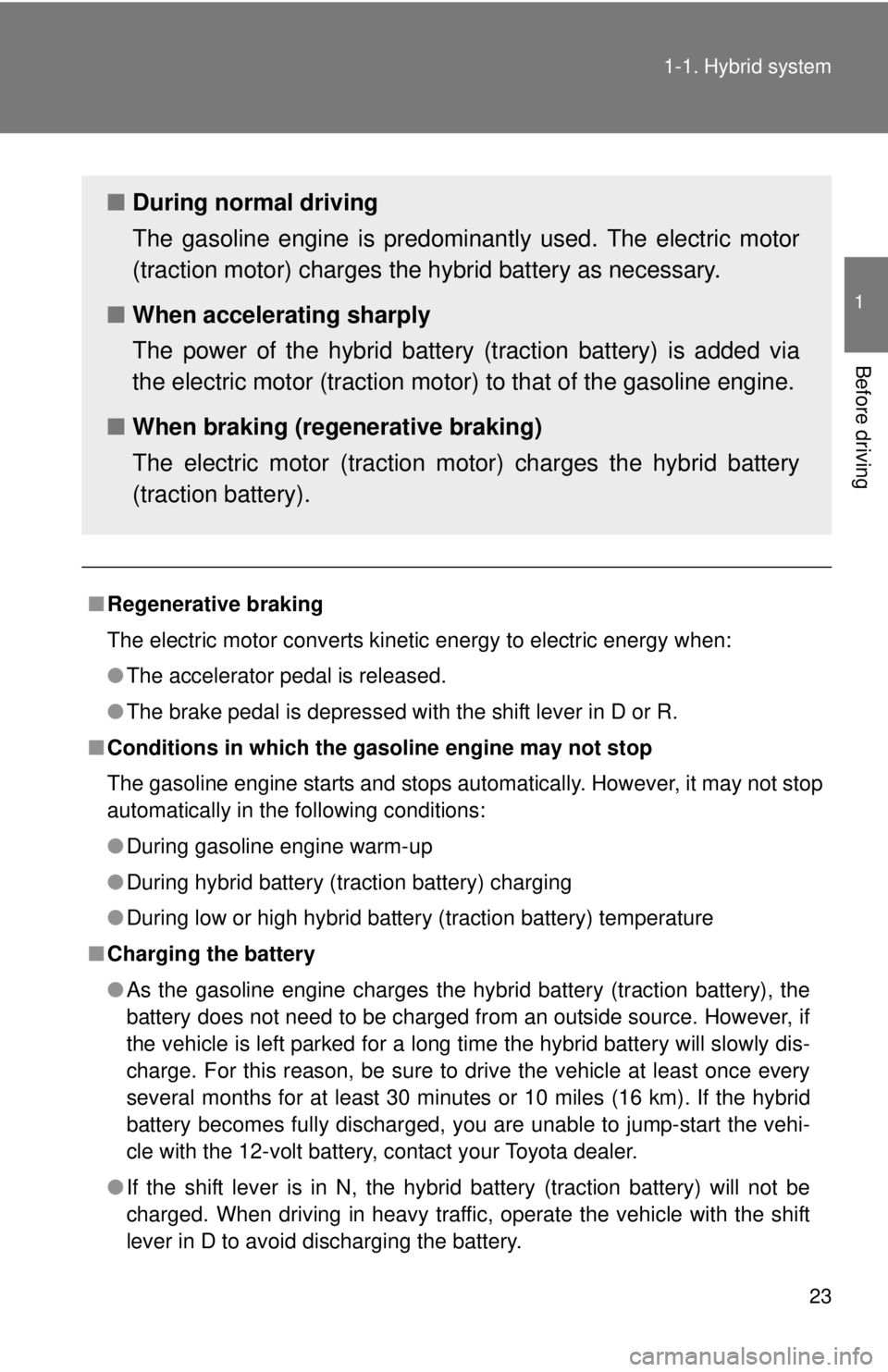Page 5 of 508

1
2
3
4
5
6
7
5
5-2. Steps to take in an emergency
If a warning light turns on or a warning buzzer
sounds... .......................... 399
If a warning message is displayed........................... 408
If you have a flat tire............ 419
If the hybrid system will not start ............................. 429
If the shift lever cannot be shifted from P............... 431
If you lose your keys ........... 432
If the electronic key does not operate properly.......... 433
If the vehicle’s 12-volt battery is discharged......... 436
If your vehicle overheats ..... 440
If the vehicle becomes stuck ................................. 444
If your vehicle has to be stopped in an
emergency ........................ 446
6-1. Specifications Maintenance data (fuel, oil level, etc.) ............ 450
Fuel information .................. 459
Tire information ................... 462
6-2. Customization Customizable features ........ 474
6-3. Initialization Items to initialize ................. 477 Reporting safety defects
for U.S. owners ................ 480
Seat belt instructions for Canadian owners
(in French) ........................ 481
SRS airbag instructions for Canadian owners
(in French) ........................ 484
Abbreviation list ......................... 496
Alphabetical index ..................... 497
What to do if... ........................... 506
6Vehicle specifications
7For owners
Index
Page 23 of 508

23
1-1. Hybrid system
1
Before driving
■
Regenerative braking
The electric motor converts kinetic energy to electric energy when:
●The accelerator pedal is released.
● The brake pedal is depressed with the shift lever in D or R.
■ Conditions in which the gasoline engine may not stop
The gasoline engine starts and stops automatically. However, it may not stop
automatically in the following conditions:
●During gasoline engine warm-up
● During hybrid battery (traction battery) charging
● During low or high hybrid battery (traction battery) temperature
■ Charging the battery
●As the gasoline engine charges the hybrid battery (traction battery), the
battery does not need to be charged from an outside source. However, if
the vehicle is left parked for a long time the hybrid battery will slowly dis-
charge. For this reason, be sure to drive the vehicle at least once every
several months for at least 30 minutes or 10 miles (16 km). If the hybrid
battery becomes fully discharged, you are unable to jump-start the vehi-
cle with the 12-volt battery, contact your Toyota dealer.
● If the shift lever is in N, the hybrid battery (traction battery) will not be
charged. When driving in heavy traffic, operate the vehicle with the shift
lever in D to avoid discharging the battery.
■ During normal driving
The gasoline engine is predominantly used. The electric motor
(traction motor) charges the hybrid battery as necessary.
■ When accelerating sharply
The power of the hybrid battery (traction battery) is added via
the electric motor (traction moto r) to that of the gasoline engine.
■ When braking (regenerative braking)
The electric motor (traction mo tor) charges the hybrid battery
(traction battery).
Page 24 of 508

24 1-1. Hybrid system
●To help prevent the 12-volt battery from becoming discharged, drive the
vehicle at least once a month, and operate the accessories only when
the “READY” indicator is on. When parking the vehicle, make sure the
doors and trunk are closed and all lights are turned off.
■ After the 12-volt battery has di scharged or has been changed or
removed
The gasoline engine may not stop even if the vehicle is running on the hybrid
battery (traction battery). If this continues for a few days, contact your Toyota
dealer.
■ Sounds and vibrations specific to a hybrid vehicle
There may be no engine sounds or vibration even though the vehicle is able
to move. Always put the shift lever in P when parked.
The following sounds or vibrations may occur when the hybrid system is
operating, and are not a malfunction:
●Motor sounds may be heard from the engine compartment.
● Sounds may be heard from the hybrid battery (traction battery) behind
the rear seat when the hybrid system starts or stops.
● Sounds may be heard from the transaxle when the hybrid system starts
or stops, or while the vehicle is idling.
● Engine sounds may be heard when accelerating sharply.
● Sounds may be heard due to the regenerative braking when you press
the brake pedal.
● Vibration may be felt when the gasoline engine starts or stops.
● Cooling fan sounds may be heard from the air intake vents behind the
rear seat.
■ Maintenance, repair, recycling, and disposal
Contact your Toyota dealer regarding maintenance, repair, recycling and dis-
posal. Do not dispose of the vehicle yourself.
Page 26 of 508
26 1-1. Hybrid system
■Hybrid battery air vent
There is an air intake vent on the
package tray for the purpose of
cooling the hybrid battery (trac-
tion battery). If the vent becomes
blocked, the hybrid battery may
overheat, leading to a reduction in
hybrid battery output.
Emergency shut off system
The emergency shut off system blocks off the high voltage current
and stops the fuel pump to minimize the risk of electrocution and fuel
leakage when a certain level of impact is detected by the impact sen-
sor. If the emergency shut off syste m activates, your vehicle will not
restart. To restart the hybrid system, contact your Toyota dealer.
Energy monitor/consumption/past record screen
You can view the status of your
hybrid system on the multi-infor-
mation display (P. 150) and the
navigation system screen*
( P. 27, 29).
The following images are exam-
ples only, and may vary slightly
from actual conditions.
*: Vehicles with Navigation System
Page 37 of 508
37
1
Before driving
1-3. Opening, closing and locking the doors
Smart key system
The following operations can be performed simply by carrying the
electronic key on your person, for example in your pocket.
(The driver should always carry the electronic key.)
Locks and unlocks the doors ( P. 3 8 )
Unlocks the trunk ( P. 3 8 )
Starts and stops the hybrid system ( P. 135)
Electronic key
Electronic key
Electronic key
Page 43 of 508

43
1-3. Opening, closing and locking the doors
1
Before driving
■
Electronic key battery depletion
●The standard battery life is 1 to 2 years. (The battery becomes depleted
even if the electronic key is not used.) If the smart key system or the
wireless remote control function does not operate, or the detection area
becomes smaller, the battery may be depleted. Replace the battery when
necessary. ( P. 372)
● If the battery becomes low, an alarm will sound in the cabin when the
hybrid system stops. (P. 415)
● To avoid serious deterioration, do not leave the electronic key within 3 ft.
(1 m) of the following electrical appliances that produce a magnetic field.
•TVs
• Personal computers
• Recharging cellular phones or cordless phones
• Table lamps
■ To operate the system properly
Make sure to carry the electronic key when operating the system. Do not get
the electronic key too close to the vehicle when operating the system from
the outside of the vehicle.
Depending on the position and holding condition of the electronic key, the
key may not be detected correctly and the system may not operate properly.
(The alarm may go off accidentally, or the door lock prevention may not func-
tion.)
■ Note for the smart key system
●Even when the electronic key is within the effective range (detection
areas), the system may not operate properly in the following cases.
• The electronic key is too close to the window or outside door handle,
near the ground, or in a high place when the doors are locked or
unlocked.
• The electronic key is near the ground or in a high place, or too close to the rear bumper center when the trunk is unlocked.
• The electronic key is on the instrument panel, package tray, floor, or in the auxiliary box of the driver's side instrument panel or glove box
when the hybrid system is started or the “POWER” switch modes are
changed.
Page 88 of 508
88
1-7. Theft deterrent system
Immobilizer system
■System maintenance
The vehicle has a maintenance-free type immobilizer system.
■ Conditions that may cause the system to malfunction
●If the key is in contact with a metallic object
● If the key is in close proximity to or touching a key to the security system
(key with a built-in transponder chip) of another vehicle
The vehicle's keys have built-in tran sponder chips that prevent the
hybrid system from starting if the key has not been previously regis-
tered in the vehicle's on-board computer.
Never leave the keys inside the vehicle when you leave the vehicle.
The indicator light flashes after
the “POWER” switch has been
turned OFF to indicate that the
system is operating.
The indicator light stops flash-
ing after the “POWER” switch
has been turned to ACCES-
SORY or ON mode to indicate
that the system has been can-
celed.
Page 124 of 508
124
2-1. Driving procedures
Driving the vehicle
The following procedures should be observed to ensure safe driv-
ing.
■ Starting the hybrid system ( P. 135)
■ Driving
With the brake pedal depressed, shift the shift lever to D. ( P. 139)
Release the parking brake. ( P. 142)
Gradually release the brake pedal and gently depress the
accelerator pedal to accelerate the vehicle.
■ Stopping
With the shift lever in D, depress the brake pedal.
If necessary, set the parking brake.
When the vehicle is stopped for an extended period of time, shift
the shift lever to P. ( P. 139)
■Parking the vehicle
With the shift lever in D, depress the brake pedal.
Set the parking brake. ( P. 142)
Shift the shift lever to P. ( P. 139)
When parking on a hill, if necessary, block the wheels.
Turn the “POWER” switch OFF and stop the hybrid system.
Lock the door, making sure that you have the electronic key
on your person.
STEP1
STEP2
STEP3
STEP1
STEP2
STEP1
STEP2
STEP3
STEP4
STEP5